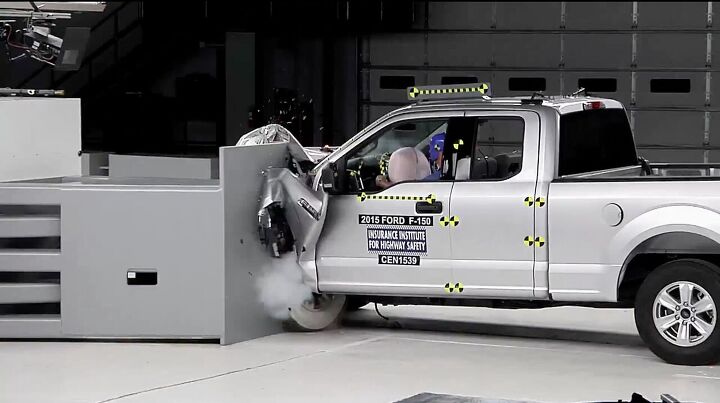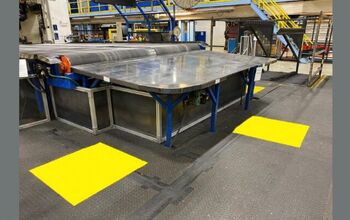Passengers Aren't Getting the Same Protection as Drivers; IIHS Threatens Another Crash Category

After reports surfaced last year of automakers only adding driver’s side small-overlap crash protection to their vehicles, the Insurance Institute for Highway Safety put the claims to the test.
A study of seven compact crossovers showed vast differences in safety between the driver and passenger side of the vehicle during small-overlap crashes, Automotive News reports, prompting the IIHS to consider adding another category to its testing criteria.
The small-overlap test was (and still is) a problem for automakers, sinking many vehicles’ ratings after IIHS added it in 2012. The Dodge Challenger was a recent victim of the test, which simulates a partial head-on collision with a vehicle or an impact with a utility pole.
Automakers quickly added reinforcements to their vehicles, but often only on the driver’s side.
In its study, the IIHS tested the current generation Toyota RAV4, Subaru Forester, Nissan Rogue, Hyundai Tucson, Mazda CX-5, Honda CR-V and Buick Encore. Every model received a “good” rating for the driver’s side, but only the Tucson scored the same rating for the passenger side. (The Tucson’s passenger-side footwell load path cropped up in TTAC’s review of the redesigned model.)
It was night and day with the RAV4, which scored a “poor” in the passenger-side test, while the Forester and Rogue scored “marginal.” During the tests, the RAV4 and Rogue recorded the largest amount of passenger footwell intrusion — 13 inches for the RAV4 and 10 inches for the Rogue.
According to the IIHS report: “The Rogue’s door hinge pillar was torn off completely, and the RAV4’s door opened. In a real crash, an open door would leave the occupant at risk for ejection.”
The remaining crossovers returned an “acceptable” rating.
“It’s not surprising that automakers would focus their initial efforts to improve small overlap protection on the side of the vehicle that we conduct the tests on,” stated David Zuby, IIHS executive vice president and chief research officer, in the report. “In fact, we encouraged them to do that in the short term if it meant they could quickly make driver-side improvements to more vehicles. As time goes by, though, we would hope they ensure similar levels of protection on both sides.”
A threat to add passenger-side small-overlap testing to its Top Safety Pick criteria would probably be enough to get automakers scrambling once again, eager to avoid a bad rating.

More by Steph Willems
Latest Car Reviews
Read moreLatest Product Reviews
Read moreRecent Comments
- 1995 SC Sometimes a car is forever tainted because of some girl you knew of that drove one lol.
- Doc423 We don't need Detroit Losers in Alabama....we've seen what they did there....Stay the Hell Out, UAW !!!
- CoastieLenn Having formerly worked for Coca Cola (and subsequently having to be part of the union), I'm of the opinion that Unions haven't actually served a viable purpose on the US landscape since about 1971 when OSHA was created. At that point, their main "reason for existence" became threatened so they had to create a new reason to exist- workforce protection. With the passage of the federal Fair Labor Standards Act in 1938 which created the Wage and Hour Commission under the Department of Labor, unions took a huge punch to the guts. Ironically, the FLSA was enacted 3 years after the UAW was formed!Now, all the really serve to do is ensure that ole Bill on that forklift that makes 4x the hourly wage of the younger guys but is 33% as productive can almost never lose his job or seniority based off performance. Bill should have retired 7 years ago, but he's gonna milk the cow for all its worth, and the Union knows it and the company can do nothing about it. /rant
- Sobhuza Trooper No downside to the all-weather tires was mentioned.If they're perfect, then just say so.
- Aja8888 The Tesla service center near me has 12 bays (full all the time) and parking for at least as many cars waiting for service or parts. No oil changes allowed though! Oh, they don't offer a loner vehicle like Lexus does.


































Comments
Join the conversation
IIHS's YouTube channel (the only one worth watching,) just posted some interesting stuff: https://www.youtube.com/user/iihs/videos
No picture of the RAV4 or Rogue - but we'll pull up a F-150 pic when it wasn't even part of the test subjects. Nope - no bias here - nothing to see folks. In other news, FCA is the first auto maker of 4 to announce they will stop using recalled airbags in NEW vehicle construction by September of this year. VW, Mitsubishi and Toyota are continuing the practice of installing Claymore mines in new 2016-17 vehicles in the factory without advising customers. Nope - no bias here.